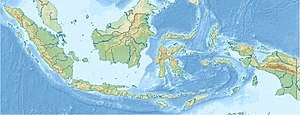Mount Tambora
| Mount Tambora | |
|---|---|

Aerial view of the caldera of Mount Tambora, formed during the colossal 1815 eruption.
|
|
| Highest point | |
| Elevation | 2,722 m (8,930 ft) |
| Prominence | 2,722 m (8,930 ft) |
| Listing |
Ultra Ribu |
| Coordinates | 8°14′48″S 117°57′30″E / 8.24667°S 117.95833°ECoordinates: 8°14′48″S 117°57′30″E / 8.24667°S 117.95833°E |
| Geography | |
| Location | Sumbawa, Lesser Sunda Islands, Indonesia |
| Geology | |
| Age of rock | 57,000 years |
| Mountain type | Stratovolcano/Caldera |
| Last eruption | 1967 ± 20 years |
Mount Tambora is an active stratovolcano which is a peninsula of and the highest peak on the island of Sumbawa in Indonesia. Sumbawa is flanked both to the north and south by oceanic crust, and Tambora was formed by the active subduction zone beneath it. This raised Mount Tambora as high as 4,300 m (14,100 ft), making it one of the tallest peaks in the Indonesian archipelago in the 18th century. After a large magma chamber inside the mountain filled over the course of several decades, volcanic activity reached a historic climax in the eruption of 10 April 1815. This eruption had a volcanic explosivity index (VEI) of 7, the only unambiguously confirmed VEI-7 eruption since the Lake Taupo eruption in about AD 180. (The 946 eruption of Paektu Mountain might also have been VEI-7.) Tambora's last eruption was in 1967. It was rated VEI-0.
With an estimated ejecta volume of 160 km3 (38 cu mi), Tambora's 1815 outburst is the largest volcanic eruption in recorded history. The explosion was heard on Sumatra, more than 2,000 km (1,200 mi) away. Heavy volcanic ash falls were observed as far away as Borneo, Sulawesi, Java, and the Maluku Islands. Most of the deaths from the eruption were from starvation and disease, as the eruptive fallout ruined agricultural productivity in the local region. The death toll was at least 71,000 people, of whom 11,000–12,000 were killed directly by the eruption; the oft-cited figure of 92,000 people killed is believed to be an overestimate.
...
Wikipedia

